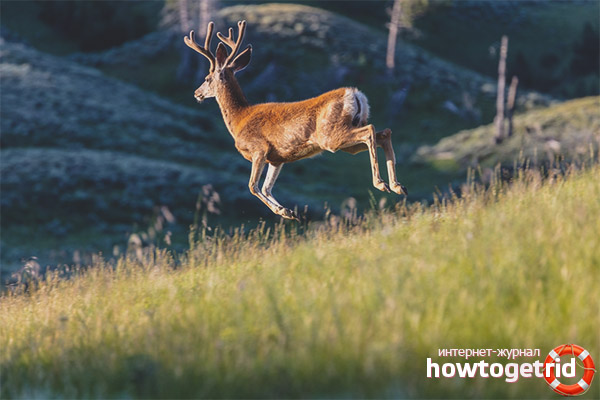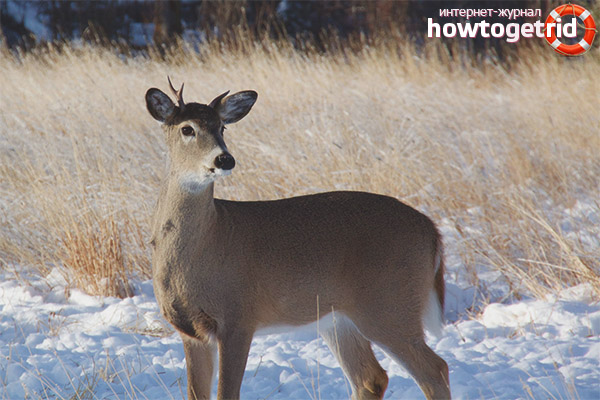The content of the article
White-tailed deer is quite common in the North American region. In the mid-20th century, this subspecies was introduced into the territory of the Scandinavian peninsula, where it was widely used. Among such representatives, deer is considered one of the largest. This species is very interesting for a more detailed study.
Description
In winter, the coat of white-tailed deer usually has a light gray tint. But by the onset of summer, it begins to shade with reddish-brown flowers, darkening towards the back. This species got its name for the light shade of the lower part of the tail. In case of danger, the animal immediately flees, lifting its tail up. His relatives, seeing a running deer, also rush in all directions.
Antlers belonging only to males begin to change after the mating season. Their shape resembles a beautiful crescent with several processes, which are usually not more than 7 pcs. Moreover, the size of the individuals themselves is completely different, depending on the subspecies. Males living in Canada can reach 1 meter at the withers and weigh up to 150 kg.
Females are generally smaller in size and weight. This is characteristic of the inhabitants of the southern part of the mainland. Individuals of only 60 cm were seen at the withers and weighing 35 kg - this classifies them as island individuals and is considered a characteristic of dwarfism. The life expectancy of animals, as a rule, varies in the range of 10-12 years.
Habitat
This species lives not only in the central part of the mainland, but also in the southern part of Canada, as well as in northern Peru. Animals are considered one of the most common, able to adapt to different living conditions. Individual herds are found even in desert regions, marshy areas, and in the forests of Connecticut. In Brazil, deer can be found on the coastal regions of the savannah, the slopes of the Andes, and in the gallery forests of tugai. In the rain forests, deer practically do not occur. It is noticed that they prefer the territory of the North of America rather than the South.
Lifestyle
It is noticed that this species of deer, as a rule, lives alone. But sometimes, outside the mating season, individuals can form small groups. Animals are not inclined to the stability of conservation of such groups, therefore, after some time, group cells can decay, and individuals again begin to lead a solitary lifestyle.
Males during the mating season can choose several females, and after about six months, small deer can appear in the light. As a rule, no more than 2 babies are born in a female. The fur of the children, like many other deer subspecies, is covered with white spots, which perfectly helps the natural disguise.
During the first 2.5 months, the mother feeds the babies with milk. Already by the winter period at the age of about six months, young growth weighs 20-35 kg. Reindeer adolescents leave their mothers in the first year of life, and young females after another year. Deer maturation occurs at the age of one and a half years.
Natural selection

White tails, like other representatives of deer, bark, berries, leaves and herbs, feed.Their stomach, due to its structure, is able to digest even poisonous species of mushrooms. Depending on the season, their diet is also undergoing changes, and sometimes these animals are able to eat not only plant foods, but also prey on chicks and mice.
The danger to the species is represented by bears, wolves, jaguars, and people. During the run, deer can gain speed up to 75 km \ h, and in case of special danger they can cover the distance of the jump 10 meters in length and 2.5 meters in height.
White tail tails are usually silent, only at a very young age they slightly bleach in communication with their mother, who answers them with a soft, hoarse sound. In danger, the deer make a sound similar to a sharp snoring, or in the dark it can be an intermittent whistle. The individuals are distinguished by a good sense of smell and sensitive hearing, but they see almost nothing in the distance.
Hunting for this species is still allowed in America, but not more than 1 deer for several days per year.
Young deer often die from predators, as adult individuals have a greater adaptability to survival, and can not only escape, but also provide proper resistance. In conditions of increased agricultural activity, there is also a decrease in the number of species. This is due to the fact that when developing new territories for the cultivation of certain crops, the natural habitat of deer is undergoing change.
Threat to the mind
Since then, a restriction has been introduced on hunting for this species, but even despite this, a different number of deer live in some regions of America. In several regions, the population has been restored to normal, while in others it is on the verge of extinction. On the territory of the American continent there are now about 14 million representatives of this species. Some subspecies previously found in these territories are currently considered completely extinct.
Video: White-tailed Deer (Odocoileus virginianus)










Submit